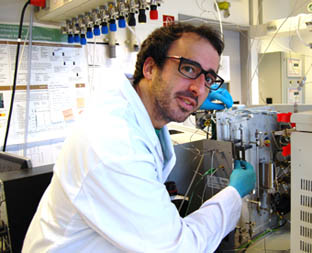
The University of Valencia has participated in the development of a new methodology which has enabled to describe in detail, for the first time, the microbial flora of the flora cavity in an archaeological population. This opens the door to the possibility of applying this technique in order to facilitate the understanding of the human evolutionary history.
Postdoctoral researcher Domingo Carlos Salazar García, doctor from the University of Valencia, has been part of the international team who has discovered the millenarian oral microbiome trapped in the teeth of skeletons of more than a thousand years, coming from the German medieval deposit of Dalheim. The key of the discovery is the dental plaque mineralised to dental calculations, which keeps bacteria and microscopic particles of food, creating a kind of receptacle for the microbiome. The result of this pioneering research on ecology of the oral microbiome and his function has been published online at Nature Genetics and has received contributions from thirty-two scientists of twenty institutions in seven countries.
Domingo Carlos Salazar, currently researched at the Max Planch Institute for Evolutionary Anthropology (Leipzig, Germany), adds that, until now, it was known that the dental calculations preserved microparticles of food remains, however, “we did not know that its degree of preservation would be so good”. Salazar García argues that it is being shown that dental calculations “are a very important window to the past, because they have the ability to provide very valuable information on health and food of our ancestors, as well as their lifestyle. Never before had we been able to obtain as much data of a so tiny sample.
Invariable bacteria responsible for periodontal disease
Research has found that the oral cavity of ancient human maintains numerous opportunistic pathogens and also that the periodontal disease is caused by the same bacteria as in the past, despite major changes in the hygiene and human diet. The international team of scientists has also discovered that the ancient human oral microbiome already had the basic genetic mechanisms for resistance to antibiotics (eight centuries before the invention of the first therapeutic antibiotics in the 1940s). In addition to information on health, the researchers, using ancient DNA analysis, have identified dietary components, such as species of plants and animals that ate ancient populations. Among them, wheat, cabbage, lamb or pork.
The work –led by Christina Warinner of the University de Zurich and the University of Oklahoma- reveals that differently from the bones, which quickly lose most of its molecular data when they are buried, the dental calculation enters the soil in a state much more stable that helps to preserve the biomolecules. For this reason, the ancient DNA analysis was not compromised by the burial of the remains.
This group of scientists has applied, for the first time, massive DNA sequencing techniques, along with other proteomics able to identify proteins preserved to them. As a consequence, it has been reconstructed the genome of the periodontal pathogens, while getting the first evidence of the ancient human diet through biomolecules. This study does not only help to improve the understanding of the evolution of the human oral microbiome, but also the origin of the periodontal disease, which causes changes in the dentition and is characterised by the chronic inflammation resulting in loss of teeth and bone. Nowadays, the severe periodontal disease affects more than 10% of the world population, linked to other of cardiovascular, pulmonary origin or type II diabetes.
Salazar García remembers that from the archaeological world until now, “it has not been given the deserved importance to the dental calculations. Therefore, it will be necessary during the excavations and subsequent processing of the material to prevent damage to part of the archaeological record which could contribute even more data than the teeth itself”.
Valencian Domingo Carlos Salazar García is a postdoctoral researcher at the Max Planck Institute for Evolutionary Anthropology, but still maintains a strong partnership with the University of Valencia. He works in biomolecular archaeology in order to reconstruct the type of food and the health state of our ancestors as well as their interaction with the environment. Graduated in medicine from the University of Valencia and in History from the same institution, with an extraordinary award, European doctor in Prehistory and Archaeology from the University of Valencia, with Excellent Cum Laude and Master in Forensic Medicine by ADEIT Foundation- University of Valencia. Salazar Garcia has over 40 publications in national and international science popularisation magazines and books. He has been invited as a speaker at institutions like the National Geographic Society and has participated in over 40 national and international conferences.
More information:
http://www.nature.com/ng/journal/vaop/ncurrent/full/ng.2906.html
Last update: 3 de march de 2014 14:36.
News release


















